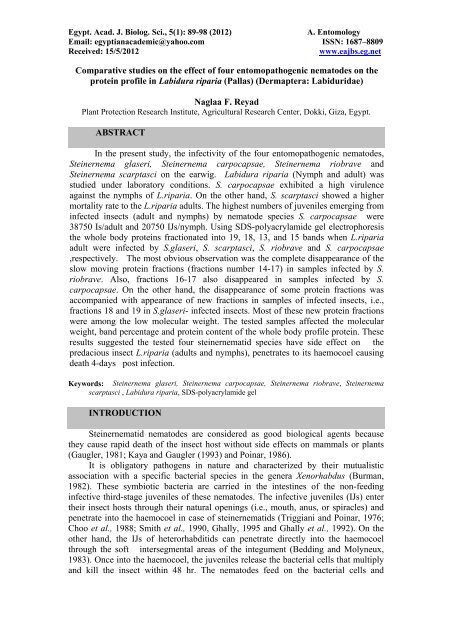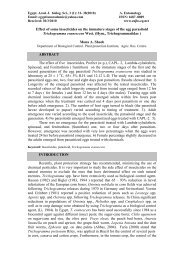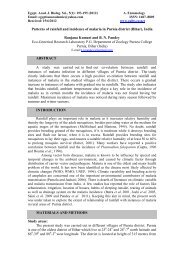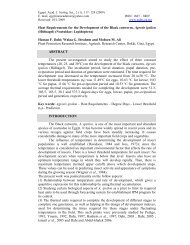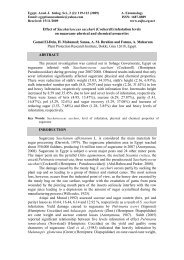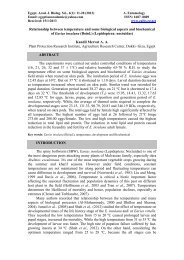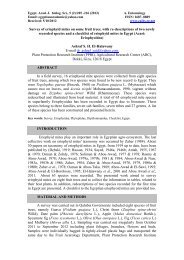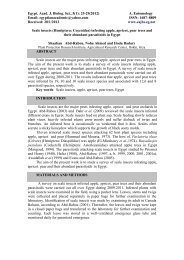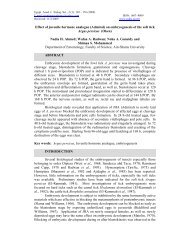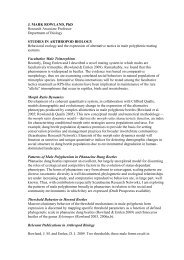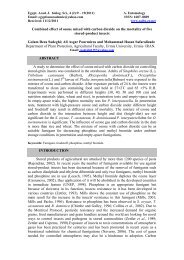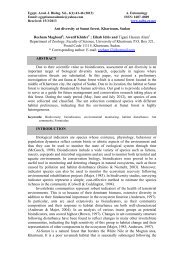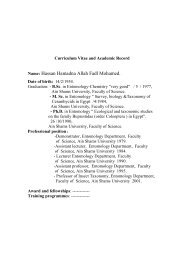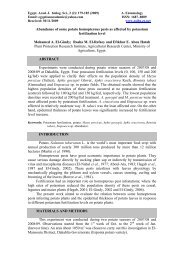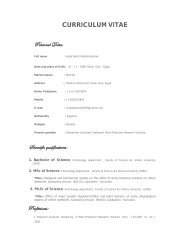Comparative studies on the effect of four entomopathogenic ...
Comparative studies on the effect of four entomopathogenic ...
Comparative studies on the effect of four entomopathogenic ...
Create successful ePaper yourself
Turn your PDF publications into a flip-book with our unique Google optimized e-Paper software.
Egypt. Acad. J. Biolog. Sci., 5(1): 89-98 (2012) A. Entomology<br />
Email: egyptianacademic@yahoo.com ISSN: 1687–8809<br />
Received: 15/5/2012 www.eajbs.eg.net<br />
<str<strong>on</strong>g>Comparative</str<strong>on</strong>g> <str<strong>on</strong>g>studies</str<strong>on</strong>g> <strong>on</strong> <strong>the</strong> <strong>effect</strong> <strong>of</strong> <strong>four</strong> <strong>entomopathogenic</strong> nematodes <strong>on</strong> <strong>the</strong><br />
protein pr<strong>of</strong>ile in Labidura riparia (Pallas) (Dermaptera: Labiduridae)<br />
Naglaa F. Reyad<br />
Plant Protecti<strong>on</strong> Research Institute, Agricultural Research Center, Dokki, Giza, Egypt.<br />
ABSTRACT<br />
In <strong>the</strong> present study, <strong>the</strong> infectivity <strong>of</strong> <strong>the</strong> <strong>four</strong> <strong>entomopathogenic</strong> nematodes,<br />
Steinernema glaseri, Steinernema carpocapsae, Steinernema riobrave and<br />
Steinernema scarptasci <strong>on</strong> <strong>the</strong> earwig. Labidura riparia (Nymph and adult) was<br />
studied under laboratory c<strong>on</strong>diti<strong>on</strong>s. S. carpocapsae exhibited a high virulence<br />
against <strong>the</strong> nymphs <strong>of</strong> L.riparia. On <strong>the</strong> o<strong>the</strong>r hand, S. scarptasci showed a higher<br />
mortality rate to <strong>the</strong> L.riparia adults. The highest numbers <strong>of</strong> juveniles emerging from<br />
infected insects (adult and nymphs) by nematode species S. carpocapsae were<br />
38750 Is/adult and 20750 IJs/nymph. Using SDS-polyacrylamide gel electrophoresis<br />
<strong>the</strong> whole body proteins fracti<strong>on</strong>ated into 19, 18, 13, and 15 bands when L.riparia<br />
adult were infected by S.glaseri, S. scarptasci, S. riobrave and S. carpocapsae<br />
,respectively. The most obvious observati<strong>on</strong> was <strong>the</strong> complete disappearance <strong>of</strong> <strong>the</strong><br />
slow moving protein fracti<strong>on</strong>s (fracti<strong>on</strong>s number 14-17) in samples infected by S.<br />
riobrave. Also, fracti<strong>on</strong>s 16-17 also disappeared in samples infected by S.<br />
carpocapsae. On <strong>the</strong> o<strong>the</strong>r hand, <strong>the</strong> disappearance <strong>of</strong> some protein fracti<strong>on</strong>s was<br />
accompanied with appearance <strong>of</strong> new fracti<strong>on</strong>s in samples <strong>of</strong> infected insects, i.e.,<br />
fracti<strong>on</strong>s 18 and 19 in S.glaseri- infected insects. Most <strong>of</strong> <strong>the</strong>se new protein fracti<strong>on</strong>s<br />
were am<strong>on</strong>g <strong>the</strong> low molecular weight. The tested samples affected <strong>the</strong> molecular<br />
weight, band percentage and protein c<strong>on</strong>tent <strong>of</strong> <strong>the</strong> whole body pr<strong>of</strong>ile protein. These<br />
results suggested <strong>the</strong> tested <strong>four</strong> steinernematid species have side <strong>effect</strong> <strong>on</strong> <strong>the</strong><br />
predacious insect L.riparia (adults and nymphs), penetrates to its haemocoel causing<br />
death 4-days post infecti<strong>on</strong>.<br />
Keywords: Steinernema glaseri, Steinernema carpocapsae, Steinernema riobrave, Steinernema<br />
scarptasci , Labidura riparia, SDS-polyacrylamide gel<br />
INTRODUCTION<br />
Steinernematid nematodes are c<strong>on</strong>sidered as good biological agents because<br />
<strong>the</strong>y cause rapid death <strong>of</strong> <strong>the</strong> insect host without side <strong>effect</strong>s <strong>on</strong> mammals or plants<br />
(Gaugler, 1981; Kaya and Gaugler (1993) and Poinar, 1986).<br />
It is obligatory pathogens in nature and characterized by <strong>the</strong>ir mutualistic<br />
associati<strong>on</strong> with a specific bacterial species in <strong>the</strong> genera Xenorhabdus (Burman,<br />
1982). These symbiotic bacteria are carried in <strong>the</strong> intestines <strong>of</strong> <strong>the</strong> n<strong>on</strong>-feeding<br />
infective third-stage juveniles <strong>of</strong> <strong>the</strong>se nematodes. The infective juveniles (IJs) enter<br />
<strong>the</strong>ir insect hosts through <strong>the</strong>ir natural openings (i.e., mouth, anus, or spiracles) and<br />
penetrate into <strong>the</strong> haemocoel in case <strong>of</strong> steinernematids (Triggiani and Poinar, 1976;<br />
Choo et al., 1988; Smith et al., 1990, Ghally, 1995 and Ghally et al., 1992). On <strong>the</strong><br />
o<strong>the</strong>r hand, <strong>the</strong> IJs <strong>of</strong> heterorhabditids can penetrate directly into <strong>the</strong> haemocoel<br />
through <strong>the</strong> s<strong>of</strong>t intersegmental areas <strong>of</strong> <strong>the</strong> integument (Bedding and Molyneux,<br />
1983). Once into <strong>the</strong> haemocoel, <strong>the</strong> juveniles release <strong>the</strong> bacterial cells that multiply<br />
and kill <strong>the</strong> insect within 48 hr. The nematodes feed <strong>on</strong> <strong>the</strong> bacterial cells and
90<br />
Naglaa F. Reyad<br />
degenerating host tissues, produce two or three generati<strong>on</strong>s, and emerge from <strong>the</strong><br />
cadavers as IJs that search for new hosts (K<strong>on</strong>do and Ishibashi, 1988).<br />
As a rule, generalist predators are regarded as <strong>the</strong> principal natural mortality<br />
factors <strong>of</strong> herbivorous insects including management (IPM) programs, <strong>the</strong>refore,<br />
c<strong>on</strong>servati<strong>on</strong> <strong>of</strong> such generalist predators can be a desirable means for reducing <strong>the</strong><br />
total amount <strong>of</strong> pesticide used.<br />
Labidura riparia Pallas (Dermaptera: Labiduridae) is regarded as an important<br />
mortality factor <strong>of</strong> insect pests in various crop fields (Ammar and Farrag, 1974;<br />
Buschman et al., 1977; Strandberg,1981a, b; Godfrey et al., 1989; Pair and Gross,<br />
1989; Kharboutli and Mack, 1993) and sometimes becomes a dominant species<br />
am<strong>on</strong>g predatory insects (Kharboutli and Mack, 1991, 1993; Kohno et al.); <strong>the</strong>refore<br />
L. riparia should be c<strong>on</strong>served in agricultural ecosystems as a promising natural<br />
mortality factor against insect pests.<br />
In <strong>the</strong> present study, we examined <strong>entomopathogenic</strong> nematodes susceptibility<br />
<strong>of</strong> L. riparia in <strong>the</strong> laboratory in order to select nematodes species that are compatible<br />
with IPM programs and we studied <strong>the</strong> <strong>effect</strong> <strong>of</strong> <strong>the</strong> <strong>four</strong> nematodes, Steinernema<br />
riobrave, Steinernema glaseri, Steinernema carpocapsae and Steinernema scarptasci<br />
<strong>on</strong> protein banding <strong>of</strong> L. riparia, in an attempt to clarify <strong>the</strong> possible humeral immune<br />
resp<strong>on</strong>se <strong>of</strong> L. riparia adult to <strong>the</strong> tested nematodes.<br />
MATERIALS AND METHODS<br />
Entomopathogenic nematodes used:-<br />
The <strong>four</strong> tested nematodes are Steinernema glaseri, Steinernema carpocapsae,<br />
Steinernema riobrave and Steinernema scarptasci. All <strong>the</strong>se species and /or strains<br />
were cultured <strong>on</strong> <strong>the</strong> last instar larvae <strong>of</strong> <strong>the</strong> greater wax moth, Galleria mell<strong>on</strong>ella<br />
according to <strong>the</strong> method <strong>of</strong> Dutky et al., (1964).<br />
The infective juveniles (IJs) were harvested by white traps as described by<br />
White (1927) at 25 ±1ć. A stock suspensi<strong>on</strong> <strong>of</strong> <strong>the</strong> IJs in sterilized water was stored<br />
at 10ć for 2 weeks until used.<br />
As for <strong>the</strong> L. riparia, nymphs were reared in glass Petri-dishes (12 cm.<br />
diameter) while <strong>the</strong> adults were placed in similar dishes c<strong>on</strong>taining a thick layer <strong>of</strong><br />
moisten sand where development, mating, ovipositi<strong>on</strong> and maternal care took place.<br />
The individuals were provided daily by sufficient amounts <strong>of</strong> newly hatched<br />
Spodoptera littoralis larvae to feed up<strong>on</strong>, (El-Husseini and Tawfic, (1971).<br />
The rearing was carried out in a room maintained at 34 ±1Ć under a complete<br />
dark c<strong>on</strong>diti<strong>on</strong>. To clarify efficacies <strong>of</strong> <strong>the</strong> <strong>four</strong> tested nematodes against L. riparia<br />
nymphs and female adults, plastic boxes (8×8×10cm), each was provided with an<br />
autoclaved sandy clay layer (2 cm height) were used. The sandy layer, in each box,<br />
received a nematode suspensi<strong>on</strong> at rate <strong>of</strong> 500 IJs/insect. Directly, a group <strong>of</strong> five last<br />
nymphal instars or newly adults was gently introduced into <strong>the</strong> box and normally<br />
supplied with food. Each nematode treatment as well as c<strong>on</strong>trol (untreated) was<br />
represented with <strong>four</strong> boxes (replicates). Four days post–treatment, died individuals<br />
were counted and cadavers were extracted using White trap technique to determine<br />
<strong>the</strong> number <strong>of</strong> juveniles emerged. The corrected mortalities were calculated according<br />
to Abbott formula (1925). The cadavers were dissected for nematode development<br />
and progeny producti<strong>on</strong>.<br />
Sodium Dodecyl Sulphate-Polyacrylamide Gel Electrophoresis (SDS-PAGE):<br />
The homogenate <strong>of</strong> treated and n<strong>on</strong>-treated larvae analyzed by SDS-PAGE<br />
based <strong>on</strong> <strong>the</strong> method <strong>of</strong> Laemmli (1970). Samples were detected to an equal volume
<str<strong>on</strong>g>Comparative</str<strong>on</strong>g> <str<strong>on</strong>g>studies</str<strong>on</strong>g> <strong>on</strong> <strong>the</strong> <strong>effect</strong> <strong>of</strong> <strong>four</strong> <strong>entomopathogenic</strong> <strong>the</strong> protein pr<strong>of</strong>ile in L. riparia 91<br />
<strong>of</strong> 0.5 M Tris-HCl, pH 6.8, c<strong>on</strong>taining 10% (w/v) SDS, 10% glycerol and 1% (w/v)<br />
bromophenol blue. All samples were <strong>the</strong>n heated at 95ºC for 4 min. and centrifuged<br />
(3000 r.p.m. for 5 min.) before applying <strong>on</strong>to <strong>the</strong> gel 12% polyacrylamide mini-gels<br />
(protein II electrophoresis cell, Bio-Rad) were used. Running c<strong>on</strong>diti<strong>on</strong>s were 200 V<br />
for 45 min. at room temperature (27-30ºC). The gels were calibrated with a broad<br />
range molecular weight (MW) marker protein (Bio-Rad). The silver staining method<br />
for protein described by Samm<strong>on</strong>s et al. (1981) was used. This method <strong>of</strong> staining is<br />
sensitive and detect as little <strong>of</strong> protein in a single band in fixative (40% methanol and<br />
10% acetic acid) overnight at room temperature and <strong>the</strong>n destined <strong>the</strong> following day<br />
using several changes <strong>of</strong> 40% methanol/10% acetic acid. The data was analyzed using<br />
gel documentati<strong>on</strong> system (gel pro-analyzer).<br />
RESULTS<br />
Virulence <strong>of</strong> nematodes<br />
It is evident from Fig. (1) that, S. carpocapsae exhibited a high virulence (about<br />
75% mortality) against <strong>the</strong> nymphs <strong>of</strong> L.riparia, <strong>the</strong> o<strong>the</strong>r three species had<br />
significantly a less virulent. On <strong>the</strong> o<strong>the</strong>r hand, S. scarptasci showed a higher<br />
mortality rate (72.5%) to <strong>the</strong> L.riparia adults.<br />
Infective juvenile producti<strong>on</strong>:<br />
The juveniles were emerged from <strong>the</strong> cadavers, <strong>the</strong> highest numbers <strong>of</strong><br />
juveniles emerging from infected insects (adult and nymphs) by nematode species S.<br />
carpocapsae were 38750 IJs /adult and 20750 IJs/nymph. On <strong>the</strong> c<strong>on</strong>trary <strong>the</strong> lowest<br />
number <strong>of</strong> juveniles emerging from infected insects (adult and nymphs) by nematode<br />
species S. glaseri. Fig (2).<br />
Fig. 1: Virulence <strong>of</strong> <strong>four</strong> <strong>entomopathogenic</strong><br />
nematodes at <strong>the</strong> rate <strong>of</strong> 500 IJs /<br />
L.riparia adults or nymphs (S.r: S.<br />
riobrave; S.g: S. glaseri; S.c: S.<br />
carpocapsae and S.s: S. scarapasci).<br />
Fig. 2: Number <strong>of</strong> juveniles emerging from<br />
L.riparia (adult and Nymph) infected<br />
by (S.r: S. riobrave; S. g: S. glaseri;<br />
S.c: S. carpocapsae and S.s:<br />
S.scarapasci.<br />
SDS-Protein electrophoresis analysis:<br />
Gel-electrophoresis is still <strong>the</strong> most widely used protein separati<strong>on</strong><br />
Sodium polyacrylamide gel electrophoresis (SDS-PAGE) analysis <strong>of</strong> protein in<br />
c<strong>on</strong>trol, nematodes -infected L.riparia is shown in Fig. (3) and Table (1). Scanning <strong>of</strong><br />
<strong>the</strong> gels revealed <strong>the</strong> presence <strong>of</strong> 17 different protein fracti<strong>on</strong>s in <strong>the</strong> c<strong>on</strong>trol sample. It<br />
was found that <strong>the</strong>re were differences between <strong>the</strong> protein patterns <strong>of</strong> infected and
92<br />
Naglaa F. Reyad<br />
n<strong>on</strong>- infected samples. The most obvious observati<strong>on</strong> was <strong>the</strong> complete disappearance<br />
<strong>of</strong> <strong>the</strong> slow moving protein fracti<strong>on</strong>s (fracti<strong>on</strong>s number 14-17) in samples infected by<br />
S. riobrave. Also, fracti<strong>on</strong>s 16-17 also disappeared in samples infected by S.<br />
carpocapsae. On <strong>the</strong> o<strong>the</strong>r hand, <strong>the</strong> disappearance <strong>of</strong> some protein fracti<strong>on</strong>s was<br />
accompanied with appearance <strong>of</strong> new fracti<strong>on</strong>s in samples <strong>of</strong> infected insects, i.e.,<br />
fracti<strong>on</strong>s 18 and 19 in S. glaseri-infected insects. Most <strong>of</strong> <strong>the</strong>se new protein fracti<strong>on</strong>s<br />
were am<strong>on</strong>g <strong>the</strong> low molecular weight .This change in <strong>the</strong> protein pr<strong>of</strong>ile indicates<br />
qualitative differences am<strong>on</strong>g <strong>the</strong> tested samples and hydrolysis <strong>of</strong> protein in <strong>the</strong><br />
infected insects.<br />
Fig. 3: Protein pattern in c<strong>on</strong>trol, and S.riobrave (laneA)-, S.scarapsci (laneB)-, S.carpocapsae (laneC)-,<br />
S. glaseri (laneD)-infected adult <strong>of</strong> L.riparia<br />
Increase in <strong>the</strong> mol. Wt. in bands no. 9-17 in samples infected by S. glaseri and<br />
S. scarptasci, also in band no. 9-13 in samples infected by S. carpocapsae as compared to<br />
c<strong>on</strong>trol.<br />
Decrease in <strong>the</strong> mol. wt. was observed in bands no. 2-13 in samples infected by<br />
S. riobrave as compared to c<strong>on</strong>trol.<br />
Band no. 12 was c<strong>on</strong>sidered as a major band since it had <strong>the</strong> highest percentage<br />
<strong>of</strong> protein in samples infected S. riobrave. Band no. 14 was <strong>the</strong> major band in samples<br />
infected by S. carpocapsae. Bands no. 16 and 18 (new band) were <strong>the</strong> major bands in<br />
samples infected by S. scarptasci. Also bands no. 17 and 18 (new band) were <strong>the</strong><br />
major bands in samples infected by S.glaseri.<br />
On <strong>the</strong> o<strong>the</strong>r hand band (no. 1) was c<strong>on</strong>sidered as a major band since it had <strong>the</strong><br />
lowest percentage <strong>of</strong> protein in samples infected by S. carpocapsae. Band no.19 (new<br />
band) was a minor band in samples infected by S.glaseri. Meanwhile band no. 2 was a<br />
minor band in samples infected by S. riobrave. While bands no. 2 and 6 were a minor<br />
band in samples infected by S. scarptasci.
1<br />
2<br />
3<br />
4<br />
5<br />
6<br />
7<br />
8<br />
9<br />
10<br />
11<br />
12<br />
13<br />
14<br />
15<br />
16`<br />
17<br />
18<br />
19<br />
<str<strong>on</strong>g>Comparative</str<strong>on</strong>g> <str<strong>on</strong>g>studies</str<strong>on</strong>g> <strong>on</strong> <strong>the</strong> <strong>effect</strong> <strong>of</strong> <strong>four</strong> <strong>entomopathogenic</strong> <strong>the</strong> protein pr<strong>of</strong>ile in L. riparia 93<br />
The largest protein c<strong>on</strong>tent (normalizati<strong>on</strong> quantity) was presented in Table (1)<br />
appeared in band no. 12 in case <strong>of</strong> samples infected by S. riobrave (612.7) as copared<br />
to c<strong>on</strong>trol band, at <strong>the</strong> same time band no. 1 and 9 showed an increase in <strong>the</strong> protein<br />
c<strong>on</strong>tent more than three time (344.23 and 378.37) <strong>the</strong> value <strong>of</strong> <strong>the</strong> c<strong>on</strong>trol.<br />
Table 1: Molecular weight, band percentage and normalizati<strong>on</strong> quantity <strong>of</strong> <strong>the</strong> electrophoretic protein<br />
pattern <strong>of</strong> <strong>the</strong> whole body homogenate <strong>of</strong> <strong>the</strong> adult <strong>of</strong> L.riparia affected by Steinernema glaseri,<br />
Steinernema carpocapsae, Steinernema riobrave and Steinernema scarptasci under laboratory<br />
c<strong>on</strong>diti<strong>on</strong>s <strong>of</strong> (25±2Ć and 40-60 % R.H. ).<br />
M.W.<br />
(KDa)<br />
98<br />
93<br />
91<br />
87<br />
73<br />
64<br />
58<br />
53<br />
47<br />
40<br />
32<br />
24<br />
21<br />
19<br />
17<br />
14<br />
11<br />
-<br />
-<br />
c<strong>on</strong>trol<br />
Band<br />
%<br />
1.56<br />
0.89<br />
2.17<br />
3.54<br />
3.86<br />
5.19<br />
2.73<br />
3.76<br />
2.22<br />
10.67<br />
14.59<br />
7.24<br />
1.64<br />
9.28<br />
9.47<br />
15.65<br />
5.54<br />
-<br />
-<br />
%<br />
To<br />
C<strong>on</strong>trol<br />
100<br />
100<br />
100<br />
100<br />
100<br />
100<br />
100<br />
100<br />
100<br />
100<br />
100<br />
100<br />
100<br />
100<br />
100<br />
100<br />
100<br />
-<br />
-<br />
M.W.<br />
98<br />
92<br />
73<br />
70<br />
64<br />
59<br />
57<br />
53<br />
49<br />
43<br />
40<br />
38<br />
32<br />
30<br />
26<br />
24<br />
15<br />
11<br />
10<br />
S.glaseri<br />
Band<br />
%<br />
2.49<br />
4.64<br />
2.47<br />
1.09<br />
2.83<br />
3.34<br />
1.49<br />
2.37<br />
1.23<br />
6.98<br />
1.62<br />
9.34<br />
5.31<br />
2.92<br />
3.82<br />
3<br />
21.04<br />
23.56<br />
0.47<br />
%<br />
To<br />
C<strong>on</strong>trol<br />
159<br />
521.3<br />
113.8<br />
30.79<br />
73.31<br />
64.35<br />
54.57<br />
63.03<br />
55.4<br />
65.41<br />
11.15<br />
129<br />
323.8<br />
31.46<br />
40.33<br />
19.16<br />
379.8<br />
N<br />
N<br />
M.W.<br />
98<br />
94<br />
93<br />
72<br />
63<br />
61<br />
56<br />
52<br />
50<br />
44<br />
39<br />
36<br />
34<br />
29<br />
25<br />
17<br />
15<br />
10<br />
-<br />
S.scaraptasci<br />
%<br />
To<br />
C<strong>on</strong>trol<br />
126.92<br />
83.14<br />
296.77<br />
78.53<br />
130.82<br />
17.72<br />
165.93<br />
34.04<br />
85.58<br />
46.67<br />
43.04<br />
25.69<br />
143.9<br />
84.15<br />
92.18<br />
120.51<br />
155.23<br />
N<br />
-<br />
S.riobrave<br />
%<br />
To<br />
C<strong>on</strong>trol<br />
344.23<br />
73.03<br />
114.74<br />
287<br />
57.77<br />
52.21<br />
86.08<br />
199.46<br />
378.37<br />
57.63<br />
28.92<br />
612.70<br />
208.53<br />
-<br />
-<br />
-<br />
-<br />
-<br />
-<br />
S.carpocapsae<br />
Bands no. 2 was <strong>the</strong> largest protein c<strong>on</strong>tent in case <strong>of</strong> samples infected by S.<br />
glaseri (521.3) as compared to c<strong>on</strong>trol band, at <strong>the</strong> same time band no. 17 showed an<br />
increase in <strong>the</strong> protein c<strong>on</strong>tent more than three time ( 379.8) <strong>the</strong> value <strong>of</strong> <strong>the</strong> c<strong>on</strong>trol.<br />
Band no.13 was <strong>the</strong> largest protein c<strong>on</strong>tent in case <strong>of</strong> samples infected by S.<br />
carpocapsae (415.9) as compared to c<strong>on</strong>trol band, at <strong>the</strong> same time band no. 14<br />
showed an increase in <strong>the</strong> protein c<strong>on</strong>tent more than three time (395.2) <strong>the</strong> value <strong>of</strong><br />
<strong>the</strong> c<strong>on</strong>tent.<br />
While bands no.2 showed an increase in <strong>the</strong> protein c<strong>on</strong>tent, two times <strong>the</strong> value<br />
in case <strong>of</strong> samples infected by S. scarptasci as compared to c<strong>on</strong>trol (296.77), also,<br />
Band no.4 and 13 in case <strong>of</strong> samples infected by S. riobrave (287 and 208.53,<br />
respectively) as compared to c<strong>on</strong>trol, also band no. 2 in case <strong>of</strong> samples infected by S.<br />
carpocapsae (207.9) as compared to c<strong>on</strong>trol.<br />
Some protein bands had <strong>the</strong> protein c<strong>on</strong>tent with nearly <strong>the</strong> same value as<br />
c<strong>on</strong>trol band, <strong>the</strong>se were: band no. 3 in case <strong>of</strong> samples infected by S. glaseri, band<br />
no. 15 in case <strong>of</strong> samples infected by S. scarptasci, band no. 3 in case <strong>of</strong> samples<br />
infected by S. riobrave and band no. 8 in case samples infected by S. carpocapsae.<br />
O<strong>the</strong>r protein bands showed a decrease in <strong>the</strong> protein c<strong>on</strong>tent for more than half <strong>the</strong><br />
value <strong>of</strong> <strong>the</strong> c<strong>on</strong>trol band as in band no. 4-11-14-15-16 with protein c<strong>on</strong>tent 30.79-<br />
11.15-31.46-40.33and 19.16 in case <strong>of</strong> samples infected by S. glaseri, bands no.6-8-<br />
12 with protein c<strong>on</strong>tent (17.72, 34.04, 25.69) in case <strong>of</strong> samples infected by S.<br />
scarptasci, bands no. 1 and 15 with protein c<strong>on</strong>tent 23.71 and 21.96 in case <strong>of</strong><br />
samples infected by S. carpocapsae.<br />
Band<br />
%<br />
1.98<br />
0.74<br />
6.44<br />
2.78<br />
5.05<br />
0.92<br />
4.53<br />
1.28<br />
1.90<br />
4.98<br />
6.28<br />
1.86<br />
2.36<br />
7.81<br />
8.73<br />
18.86<br />
8.6<br />
14.8<br />
-<br />
M.W.<br />
98<br />
79<br />
73<br />
58<br />
56<br />
52<br />
48<br />
43<br />
37<br />
35<br />
31<br />
19<br />
11<br />
-<br />
-<br />
-<br />
-<br />
-<br />
-<br />
Band<br />
%<br />
5.37<br />
0.65<br />
2.49<br />
10.16<br />
2.23<br />
2.71<br />
2.35<br />
7.50<br />
8.40<br />
6.15<br />
4.22<br />
44.36<br />
3.42<br />
-<br />
-<br />
-<br />
-<br />
-<br />
-<br />
M.W.<br />
98<br />
96<br />
91<br />
72<br />
61<br />
58<br />
55<br />
52<br />
49<br />
44<br />
40<br />
34<br />
31<br />
19<br />
11<br />
-<br />
-<br />
-<br />
-<br />
Band<br />
%<br />
0.37<br />
1.85<br />
3.64<br />
6.99<br />
6.90<br />
3.34<br />
1.34<br />
3.75<br />
1.97<br />
8.33<br />
6.36<br />
9.59<br />
6.82<br />
36.67<br />
2.08<br />
-<br />
-<br />
-<br />
-<br />
%<br />
To<br />
C<strong>on</strong>trol<br />
23.71<br />
207.9<br />
167.7<br />
197.5<br />
178.8<br />
64.35<br />
49.08<br />
99.73<br />
88.73<br />
78.06<br />
43.59<br />
132.5<br />
415.9<br />
395.2<br />
21.96<br />
-<br />
-<br />
-<br />
-
94<br />
DISCUSSION<br />
Naglaa F. Reyad<br />
These results suggested <strong>the</strong> tested <strong>four</strong> steinernematid species have aside <strong>effect</strong><br />
<strong>on</strong> <strong>the</strong> predacious insect L.riparia (adults and nymphs), penetrates to its haemocoel<br />
causing death 4-days post infecti<strong>on</strong>. (Shamseldean et al., 1999).<br />
Similarly, Reyad and Ibrahim (2008) found that, <strong>the</strong> earwig Euborella annulipes<br />
(adults and nymphs) exposed to Steinernema glaseri, Steinernema carpocapsae,<br />
Steinernema riobrave and Steinernema abbassi at <strong>the</strong> dose 500 IJs / insect showed a<br />
high virulence against this insects. On <strong>the</strong> c<strong>on</strong>trary <strong>of</strong> El-Mahdi (1996) who found<br />
that, L. riparia nymphs and adults exposed to S. carpocapsae and Heterorhabditis<br />
bacteriophra at higher doses (10000 IJs) did not show any death symptoms over 20<br />
days post treatment.<br />
Poinar and Thomas (1966) indicated that differences in <strong>the</strong> rate <strong>of</strong> reproducti<strong>on</strong><br />
<strong>of</strong> <strong>entomopathogenic</strong> nematodes were due to quality <strong>of</strong> food reserves and not to <strong>the</strong><br />
size and/or weight <strong>of</strong> <strong>the</strong> tested insect. Both <strong>the</strong> growth and propagati<strong>on</strong> <strong>of</strong><br />
Steinernema sp. and Heterorhabditis sp. are closely associated with <strong>the</strong>ir symbiotic<br />
bacterium. They also added that since <strong>the</strong> nematodes feed <strong>on</strong> <strong>the</strong> disintegrated insect<br />
tissues, <strong>the</strong>refore, <strong>the</strong> nematode development is influenced by <strong>the</strong> available bacteria<br />
and insect tissues. The rate <strong>of</strong> emergence in nematode IJs from insect hosts absolutely<br />
depends <strong>on</strong> <strong>the</strong> balance between <strong>the</strong> Pathogenicity <strong>of</strong> nematode/bacterium complex<br />
and <strong>the</strong> development <strong>of</strong> a defense mechanism in <strong>the</strong> insects against <strong>the</strong>m. After<br />
pathogens penetrate <strong>the</strong> insects’ structural barriers, <strong>the</strong>y rely solely <strong>on</strong> an efficient<br />
innate immune system which shares many characteristics with <strong>the</strong> innate immune<br />
system <strong>of</strong> vertebrates. Insect innate immune system comprises both humoral and<br />
cellular resp<strong>on</strong>ses (Pinheiro and Ellar, 2006, Lemaitre and H<strong>of</strong>fmann, 2007).<br />
Insect humoral defenses include <strong>the</strong> producti<strong>on</strong> <strong>of</strong> a potent arsenal <strong>of</strong> antimicrobial<br />
peptides (AMPs) (Pinheiro and Ellar, 2006, Lemaitre and H<strong>of</strong>fmann, 2007),<br />
coagulati<strong>on</strong>, and melanizati<strong>on</strong> led by protease cascades (Kanost et al., 2004). Insect<br />
cellular defense refers to haemocyte-mediated immune resp<strong>on</strong>ses, such as<br />
phagocytosis, nodulati<strong>on</strong>, and encapsulati<strong>on</strong> (Lavine and Strand, 2002). The<br />
encapsulati<strong>on</strong> process involves cell adhesi<strong>on</strong> and melanizati<strong>on</strong> (Eslin and Prevost,<br />
2000).<br />
K<strong>on</strong>do and Ishibashi (1986; 1987 and 1988) c<strong>on</strong>cluded that <strong>the</strong> lower<br />
susceptibility <strong>of</strong> S. litura than Galleria mell<strong>on</strong>ella larvae to three Steinernema sp. (S.<br />
feltiae, S. bibi<strong>on</strong>is and S. glaseri) was mainly due to <strong>the</strong> higher resistance level against<br />
invading nematode ra<strong>the</strong>r than <strong>the</strong> higher defense against nematode invasi<strong>on</strong>. They<br />
also added that <strong>the</strong> propagati<strong>on</strong> and establishment <strong>of</strong> <strong>the</strong>se nematodes would be<br />
difficult in moist soil c<strong>on</strong>taining a large number <strong>of</strong> fungi and o<strong>the</strong>r saprophytic<br />
microorganisms.<br />
In accordance with <strong>the</strong> present findings, Abdel-Kawy (1985) reported that<br />
electrphoretic analysis <strong>of</strong> haemolymph protein in fullgrown larvae <strong>of</strong> S. littoralis<br />
infected with <strong>the</strong> nematode Steinernema carpocapsae revealed complete<br />
disappearance <strong>of</strong> some protein fracti<strong>on</strong>s, in additi<strong>on</strong> to decreased optical density <strong>of</strong><br />
some o<strong>the</strong>rs. However, El-Bishry et al (1997) found no qualitative differences in<br />
haemolymph protein <strong>of</strong> Manduca sexta and S. littoralis infected with <strong>the</strong> same<br />
nematode species, but all <strong>the</strong> changes were c<strong>on</strong>fined to <strong>the</strong> quantitative <strong>on</strong>es. Fur<strong>the</strong>r,<br />
El-Bishry (1989) reported that haemolymph protein <strong>of</strong> S. littoralis was markedly<br />
reduced 30 hr post-nematode infecti<strong>on</strong>. He attributed this reducti<strong>on</strong> to <strong>the</strong> proteolytic<br />
activity detected in <strong>the</strong> haemolymph <strong>of</strong> infected larvae, this activity was believed to<br />
be <strong>the</strong> main cause <strong>of</strong> <strong>the</strong> host quick death (Pi<strong>on</strong>ar, 1966; El-Bishry, 1989). In additi<strong>on</strong>,
<str<strong>on</strong>g>Comparative</str<strong>on</strong>g> <str<strong>on</strong>g>studies</str<strong>on</strong>g> <strong>on</strong> <strong>the</strong> <strong>effect</strong> <strong>of</strong> <strong>four</strong> <strong>entomopathogenic</strong> <strong>the</strong> protein pr<strong>of</strong>ile in L. riparia 95<br />
Kucera and Mracek (1989) could partially purified 3 proteolytic enzymes from<br />
haemolymph <strong>of</strong> G. mell<strong>on</strong>ella larvae infected with Steinernematid nematodes. This<br />
proteolutic activity was proved by El-Bishry (1989), where he could have separated 7<br />
protein fracti<strong>on</strong>s having this activity from haemolymph <strong>of</strong> S. littoralis larvae infected<br />
with <strong>the</strong> nematode S. feltiae. He also found that <strong>the</strong>se fracti<strong>on</strong>s were lethal when<br />
injected into haemocoel <strong>of</strong> healthy larvae and a positive relati<strong>on</strong> could be detected<br />
between <strong>the</strong>ir enzymatic activity and <strong>the</strong>ir lethal <strong>effect</strong>. The source <strong>of</strong> <strong>the</strong>se enzymes<br />
may be <strong>the</strong> nematode or its symbiotic bateria. Bleakley and Neals<strong>on</strong> (1988) reported<br />
that cells <strong>of</strong> <strong>the</strong> sec<strong>on</strong>dary from <strong>of</strong> <strong>the</strong> bacterium Xenorhabdus luminescens were<br />
deficient in pigmentati<strong>on</strong>, extracellular antibiotic, protease and lipase activities.<br />
Schmidt et al. (1988) found that <strong>the</strong> bacterium X. luminescens produces1 <strong>on</strong>ly <strong>on</strong>e<br />
extracelluar protease. Kucera and Mracek (1989) purified <strong>on</strong>e proteolytic enzyme<br />
from <strong>the</strong> invasive juveniles <strong>of</strong> S. kraussei and two from <strong>the</strong> associated bacterium, X.<br />
nematophilus. Protease activity <strong>of</strong> <strong>the</strong> infective juveniles is believed to be resp<strong>on</strong>sible<br />
for disorganizing <strong>the</strong> gut cells <strong>of</strong> insects, allowing penetrati<strong>on</strong> <strong>of</strong> <strong>the</strong> nematode into<br />
<strong>the</strong> haemocoel, and acts as an anhibitor, acting <strong>on</strong> <strong>the</strong> immune proteins <strong>of</strong> <strong>the</strong> insects<br />
(Laum<strong>on</strong>d et al. 1979). Rubtsov (1967) suggested that degrade <strong>the</strong> haemolymph<br />
proteins to provide an amino acid source. He added that this has yet to be<br />
dem<strong>on</strong>strated but should be examined al<strong>on</strong>g with <strong>the</strong> hypo<strong>the</strong>sis that <strong>the</strong> host may<br />
initiate protein hydrolysis in resp<strong>on</strong>se to nutri<strong>on</strong>al stress <strong>of</strong> endocrine manipulati<strong>on</strong>.<br />
The importance <strong>of</strong> isolating and identifying <strong>the</strong> toxins released by <strong>the</strong><br />
entomopathgogenic nematodes and <strong>the</strong>ir associated bacteria lies in <strong>the</strong> possibility <strong>of</strong><br />
c<strong>on</strong>ferring resistance to insects in plants by incorporating <strong>the</strong> gene an coding for <strong>the</strong><br />
toxin into <strong>the</strong> genoplasm <strong>of</strong> ec<strong>on</strong>omics crops (Laum<strong>on</strong>d et al., 1989).<br />
Finally, Reyad (2005) also found that <strong>the</strong>re were great differences between <strong>the</strong><br />
protein patterns <strong>of</strong> infected 4 th instar larvae <strong>of</strong> S. littoralis by S. riobrave and<br />
Heterorhabditis sp. and n<strong>on</strong>-infected samples. The most obvious observati<strong>on</strong> was <strong>the</strong><br />
complete disappearance <strong>of</strong> <strong>the</strong> slow moving protein fracti<strong>on</strong>s (fracti<strong>on</strong>s number 1-4)<br />
in all samples <strong>of</strong> infected insects. The disappearance <strong>of</strong> some protein fracti<strong>on</strong>s was<br />
accompanied with <strong>the</strong> appearance <strong>of</strong> new fracti<strong>on</strong>s in samples <strong>of</strong> infected insects<br />
REFERENCES<br />
Abbott, W. S. (1925): A method <strong>of</strong> computing <strong>the</strong> <strong>effect</strong>iveness <strong>of</strong> an insecticide. J.<br />
Ec<strong>on</strong>. Entomlo., 18: 265-267.<br />
Abdel-Kawy, A. M. (1985): Biological c<strong>on</strong>trol <strong>of</strong> some lepidoprous pests by <strong>the</strong><br />
nematode, Neoaplectana carpocapsae and <strong>the</strong> physiological changes associated<br />
with it. Ph. D. Thesis. Fac. Agric. Cairo, Univ.<br />
Ammar, E. D. and S. M. Farrag (1974): Studies <strong>on</strong> <strong>the</strong> behav- iour and biology <strong>of</strong> <strong>the</strong><br />
earwig Labidura riparia Pallas (Derm., Labiduridae). Z. Ang. Entomol. 75:<br />
189–196.<br />
Annu. Rev. Immunol., 25: 697-743.<br />
Bedding, R. A. and A. S. Molyneux (1983): Penetrati<strong>on</strong> <strong>of</strong> insect cuticle by infective<br />
juvenile <strong>of</strong> Heterorhabditis spp. Heterorhabditidae: Nematoda). Nematologica,<br />
28: 354-359.<br />
Biochem. Mol. Biol., 32: 1295-1309.<br />
Bradford, M.M. (1976): A rapid and sensitive method for <strong>the</strong> quantificati<strong>on</strong> <strong>of</strong><br />
microgram quantities <strong>of</strong> protein utilizing <strong>the</strong> principle <strong>of</strong> protein dye binding.<br />
Analytical Biochemistry, 72: 248-254.<br />
Burman, M. (1982): Neoaplectanat carposcapsae: Toxins producti<strong>on</strong> by axenic insect
96<br />
Naglaa F. Reyad<br />
parasitic nematodes. Nematologica, 28: 62-70.<br />
Buschman, L. L., W. H. Whitcomb, R. C. Hemenway, D. L. Mays, R. Nguyen, N.<br />
C. Leppla and B. J. Smittle (1977): Predators <strong>of</strong> velvetbean caterpillar eggs in<br />
Florida soy- beans. Envir<strong>on</strong>. Entomol. 6: 403-407.<br />
Choo, H. Y.; Kaya, H. K. and Reed, D. K. (1988): Biological c<strong>on</strong>trol <strong>of</strong> <strong>on</strong>i<strong>on</strong> maggot<br />
and tobacco cutworm with insect parasitic nematodes Steinernema felita and<br />
Heterorhabditis heliothidis. Korean J. Appl. Ent., 27 (4): 185-189.<br />
Dutky, S. R., Thomps<strong>on</strong>, J. V. and Cantwell, G. E. (1964): A technique for <strong>the</strong> mass<br />
propagati<strong>on</strong> <strong>of</strong> <strong>the</strong> DD-136 nematode. J. Insect. Pathol, 6: 417- 422.<br />
El-Bishry, M. H.; Al-Elimi, M. H.; Eid, A. M. H. and Korashy, M. A. (1997): Studies<br />
<strong>on</strong> <strong>the</strong> mode <strong>of</strong> acti<strong>on</strong> <strong>of</strong> <strong>the</strong> entomopa<strong>the</strong>gnic nematodes <strong>of</strong> <strong>the</strong> genus<br />
Heterorhabditis. I. Effect <strong>on</strong> haemolymph protein, amino acids c<strong>on</strong>tent and<br />
esterase activity. Egyt. J. Biolo. Pest C<strong>on</strong>tr., 7(2):79-83.<br />
El-Bishry,M.H. (1989): Studies <strong>the</strong> utilizati<strong>on</strong> <strong>of</strong> <strong>the</strong> entomogenous nematode in<br />
c<strong>on</strong>trolling some pest in Egypt. Ph.D. Thesis, Fac. Agric., Cairo Univ., 81pp.<br />
El-Husseini, M.M. and M.F.S. Tawfik (1971): The nutriti<strong>on</strong>al <strong>effect</strong> <strong>of</strong> animal and<br />
plant diets <strong>on</strong> <strong>the</strong> development and fecundity <strong>of</strong> Euborellia annulipes (Lucas)<br />
(bull. Soc. Ent. Egypt, LV, pp. 219-229).<br />
El-Mahdi, E. F. (1996): Interacti<strong>on</strong>s between bioc<strong>on</strong>trol agents <strong>of</strong> <strong>the</strong> greasy<br />
cutworm,Agrotis ipsil<strong>on</strong> (Lepidoptera: Noctuidae). (Unpublished Ph.D. Thesis,<br />
Fac. <strong>of</strong> Agric., Cairo Univ.).<br />
Gaugler, R. (1981): Biological c<strong>on</strong>trol potential <strong>of</strong> neoaplectanid nematodes. J.<br />
Nematol., 13: 241-249.<br />
Ghally, S. E.; Kamel, E. G. and Naser, N. M. (1992): <str<strong>on</strong>g>Comparative</str<strong>on</strong>g> <str<strong>on</strong>g>studies</str<strong>on</strong>g> <strong>on</strong> <strong>the</strong><br />
producti<strong>on</strong> <strong>of</strong> invasive larvae <strong>of</strong> Steinernema feltiae Filipjev nematodes with<br />
insect host. J. Egypt. Society <strong>of</strong> Parasitology, 22 (3): 683-692.<br />
Ghally, S. E. (1995): Some factors affecting <strong>the</strong> activity and pathogenicity <strong>of</strong><br />
Heterorhabditis heliothidis and Steinernema carpocapsae nematodes. J. Egypt.<br />
Soc. Parasitol., 25 (1): 125-135; 22 ref.<br />
Godfrey, K. E., W. H. Whitcomb and J. L. Stumac (1989): Arthropod predators <strong>of</strong><br />
velvetbean caterpillar, Anticarsia gemmatalis Hübner (Lepidoptera: Noctuidae),<br />
eggs and larvae. Envir<strong>on</strong>. Entomol. 18: 118–123.<br />
Kanost, M.; Jiang, H.; Yu, X. (2004): Innate immune resp<strong>on</strong>ses <strong>of</strong> a lepidopteran<br />
insect, Manduca sexta. Immunol. Rev., 198: 97-105.<br />
Kaya, H.K.; and Gaugler, R. (1993): Entomopathogenic nematodes. Ann. Rev.<br />
Entomol., 38: 181-206.<br />
Kharboutli, M. S. and Mack, T. P. (1993): Comparis<strong>on</strong> <strong>of</strong> three methods for sampling<br />
arthropod pests and <strong>the</strong>ir nat- ural enemies in peanut fields. J. Ec<strong>on</strong>. Entomol.<br />
86: 1802–1810.<br />
Kharboutli, M. S. and T. P. Mack (1991): Relative and sea- s<strong>on</strong>al abundance <strong>of</strong><br />
predaceous arthropods in Alabama peanut field as indexed by pitfall traps. J.<br />
Ec<strong>on</strong>. Ento- mol. 84: 1015–1023.<br />
KOHNO, k.; Takeda, M. and Hamamura, T. (2007): Insecticide susceptibility <strong>of</strong> a<br />
generalist predator Labidura riparia (Dermaptera: Labiduridae) Appl. Entomol.<br />
Zool. 42 (3): 501–505.<br />
K<strong>on</strong>do, E. and Ishibasli, N. (1984): Infectivity and multiplicati<strong>on</strong> <strong>of</strong> Steinernema<br />
feltiae (Str. Mexican) <strong>on</strong> <strong>the</strong> comm<strong>on</strong> cutworm, Spodoptera litura. Japanese J.<br />
Appl. Ent. & Zool., 28 (4): 229-236.<br />
K<strong>on</strong>do, E. and Ishibshi, N. (1986): Infectivity and propagati<strong>on</strong> <strong>of</strong> entomogenous<br />
nematodes, Steinernema spp., <strong>on</strong> <strong>the</strong> comm<strong>on</strong> cutworm, Spodoptera litura
<str<strong>on</strong>g>Comparative</str<strong>on</strong>g> <str<strong>on</strong>g>studies</str<strong>on</strong>g> <strong>on</strong> <strong>the</strong> <strong>effect</strong> <strong>of</strong> <strong>four</strong> <strong>entomopathogenic</strong> <strong>the</strong> protein pr<strong>of</strong>ile in L. riparia 97<br />
(Lep.: Noctuidae). Appl. Entomol. Zool., 21 (1): 95-108.<br />
K<strong>on</strong>do, E. and N. Ishibashi (1987): <str<strong>on</strong>g>Comparative</str<strong>on</strong>g> infectivity and development <strong>of</strong> <strong>the</strong><br />
entomogenous insect larvae, Spodoptera litura (Noctuidae) and Galleria<br />
mell<strong>on</strong>ella (Galleridae). Jpn. J. Nematol., 17: 35-41.<br />
K<strong>on</strong>do, F. (1989): Studies <strong>on</strong> <strong>the</strong> infectivity and propagati<strong>on</strong> <strong>of</strong> entomogenous<br />
nematodes, Steinernema sp., (Rhoabditidae: Steinernematidae), with comm<strong>on</strong><br />
cutworm, Spodoptera litura (Lepidoptera: Noctuidae). Bull. Fac. Agric. Saga<br />
Univ., 68: 1-88.<br />
Kucera, M. and Mracek, Z. (1989): Proteolytic enzymes <strong>of</strong> <strong>the</strong> invasive larvae <strong>of</strong><br />
<strong>entomopathogenic</strong> Steinernematidae nematodes. Acta Entomol. Bohemoslov.,<br />
86:193-202.<br />
Laemmili, U.K. (1970): Cleavage <strong>of</strong> structural proteins during <strong>the</strong> assembly <strong>of</strong> <strong>the</strong><br />
head <strong>of</strong> Bacteriophage T4. Nature, 227: 680-685.<br />
Laum<strong>on</strong>d, C.; H. Maule<strong>on</strong> and A. Kermarrec (1979): D<strong>on</strong>nes nouvelles sur le spectre<br />
d'hotes et le parasitism du nematode entomophage Neoaplectana carpocapsae.<br />
Entomophaga, 24: 13-27.<br />
Lavine, M.; Strand, M. (2002): Insect haemocytes and <strong>the</strong>ir role in immunity. Insect<br />
Biochem. Mol. Biol., 32: 1295-1309.<br />
Lemaitre, B.; H<strong>of</strong>fmann, J. (2007): The host defense <strong>of</strong> Drosophila melanogaster.<br />
Annu. Rev. Immunol., 25: 697-743.<br />
Pair, S. D. and H. R. Gross (1989): Seas<strong>on</strong>al incidence <strong>of</strong> fall armyworm<br />
(Lepidoptera: Noctuidae) pupal parasitism in corn by Diapetimorpha introita<br />
and Cryptus albitarsis (Hymenoptera: Ichneum<strong>on</strong>idae). J. Entomol. Sci.<br />
24:339–343.<br />
Pinheiro, V.; Ellar, D. (2006): How to kill a mocking bug? Cell Microbiol., 8: 545-<br />
557.<br />
Poinar, G. O. (1986): Entomogenous nematode. In "Biological plant and Health<br />
Protecti<strong>on</strong>" (B. D. Franz, ED.), pp. 95-121. Fisher-Verlag. Stuttgart.<br />
Poinar, G. O., Jr. (1967): Descripti<strong>on</strong> and tax<strong>on</strong>omic positi<strong>on</strong> <strong>of</strong> <strong>the</strong> DD-136<br />
nematode (Steinernematidae, Rhabditida) and its relati<strong>on</strong>ship to Neoaplectana<br />
carpocapsae Weiser. Proc. Helm. Soc. Wash., 34:199-209.<br />
Reyad, N. F. (2005): Effect <strong>of</strong> <strong>the</strong> entomopa<strong>the</strong>gnic nematode Steinernema riobrave,<br />
Heterorhabditis sp., and <strong>the</strong> fungus Beauveria bassiana <strong>on</strong> <strong>the</strong> cott<strong>on</strong> leafworm,<br />
Spodoptera littoralis (Boisd.) (Lepidoptera: Noctuidae). Ph.D. Thesis, Fac. <strong>of</strong><br />
Science., Cairo Univ.).<br />
Reyad, N. F. and Ibrahim, S. M. (2008): Mortality and changes in digestive enzymes<br />
in <strong>the</strong> earwig Euborellia annulipes (Lucas) (Derm., Labiduridae) infected with<br />
<strong>entomopathogenic</strong> nematodes Bull. Soc. Ent. Egypt, Ec<strong>on</strong>. Ser., 34:61-67.<br />
Rubstov, I. A. (1967): Scheme and organs <strong>of</strong> <strong>the</strong> extraintesinal digesti<strong>on</strong> <strong>of</strong><br />
mermithids. IZV. Akad. Nauk. SSSR, Ser. Niol., 10: 883-891.<br />
Rubstov, I. A. (1971): Protective and mutualistic relati<strong>on</strong>ships between <strong>the</strong> insect and<br />
its parasites. Obsch. Biol., 32: 193-203.<br />
Samm<strong>on</strong>s, D. W.; Adams, L. D. and Nishizawa, E.E. (1981): Ultra-sensitive silver<br />
based color staining <strong>of</strong> polypeptides in polyacrylemide gels. Electrophoresis, 2:<br />
135.<br />
Schmidt, S. P. and Platzer, E. G. (1979): Changes in body tissues and haemolymph<br />
compositi<strong>on</strong> <strong>of</strong> Culex pipiens in resp<strong>on</strong>se to infecti<strong>on</strong> by Romanomermis<br />
culicivorax. J. Inverteber. Pathol., 36: 240-254.<br />
Shamselden, M. M.; Abd-Elgawad, M. M. and Atwa, A. A. (1999): Factors affecting<br />
pathogenicity <strong>of</strong> an Egyptian strain <strong>of</strong> Heterorhabditis indicus (Nematoda:
98<br />
Naglaa F. Reyad<br />
Hetrorhabditidae) infecting <strong>the</strong> cott<strong>on</strong> leafworm, Spodoptera littoralis (Lep.,<br />
Noctuidae). Internati<strong>on</strong>al J. <strong>of</strong> Nematol., 9(1):90-94.<br />
Triggiani, O. and Poinar, G. O. (1976): Infecti<strong>on</strong> <strong>of</strong> adult Lepidoptera by<br />
Neoaplectana carpocapsae (Nematoda). (J. Inverteber. Pathol., 27:413-414).<br />
White, G. F. (1927): Amethod for obtaining infective nematode larvae from cultures.<br />
(Science (Washingt<strong>on</strong>, DC) 66:302-303.<br />
ARABIC SUMMARY<br />
ةرشحل ىنيتوربلا فيصوتلا ىلع تارشحلل ةضرمملا ادوتامينلا نم عاونأ ةعبرأ ريثأت ىلع ةنراقم تاسارد<br />
ةريبكلا زوجعلا ةربا<br />
دمحأ ضاير ىحتف ءلاجن<br />
رصم - ةزيجلا ،ىقدلا ،ةيعارزلا ثوحبلا زكرم ،تاتابنلا ةياقو ثوحب دھعم<br />
زوجعلا ةربا نم غلابلا روطلا ىلع تارشحلل ةضرمملا ادوتامينلا نم عاونأ ةعبرأ ةباصا ةسارد مت<br />
. ( SDS-PAGE) ىئابرھكلا ديرفتلا ةقيرط عابتاب ةرشحلل تانيتوربلا ليلحت مت كلذ ىلا ةفاضلااب ةريبكلا<br />
روطلاب ةباصلاا ثادحا ىلع ةردق رثكأ تناك S.carpocapsae ادوتامينلا نأ ةساردلا تحضوأ دقلو<br />
ةباصلاا ثادحا ىلع ةردق رثكأ تناك S.scarptasciادوتامينلا<br />
امنيب ةريبكلا زوجعلا ةربا ةرشحل لماكلا ريغ<br />
ناك ثيح . صلاختسلاا نم ةجتانلا ادوتامينلا<br />
نمةيدعملا راوطلاا دادعأ ترثأت اضيأو<br />
، ةرشحلل لماكلا روطلاب<br />
ريغ روطلا/<br />
ةيدعم ةقري 20750)<br />
و ( لماكلا روطلا/<br />
ةيدعم ةقري 38750)<br />
ةيدعملا تاقريلا كلت نم جاتنا ىلعأ<br />
. S.carpocapsae ادوتامينلا قيبطت دنع ( لماكلا<br />
SDS- ىئابرھكلا<br />
ديرفتلا ةقيرط عابتاب ةباصملا تارشحلل تانيتوربلا ليلحت للاخ نم حضتا دقلو<br />
تاذ تانيتوربلا ءافتخا وھ ةابتنلال ةتفلملا ةرھاظلا تناكو ، نيتوربلا عاونأ ضعب روھظ وأ ءافتخا ( PAGE)<br />
ةمدختسملا ادوتامينلا عاونأب ةباصلال ةجيتن ىئابرھكلا ديرفتلا ىف ةئيطبلا ةكرحلا


